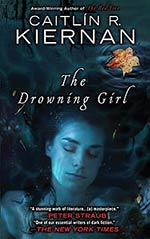
![]() FeminineFantastique
FeminineFantastique
4/17/2014
![]()
I bought The Drowning Girl, Caitlìn Kiernan's 2012 novel that won the Stoker Award and was nominated for practically every speculative fiction literary award ever, on a road trip. It happened thusly: my spouse was driving as I was finishing another of the author's novels, The Red Tree. I demanded that he pull over and find a place with free wi-fi. We went to McDonald's, and I ordered him a chocolate milkshake that he didn't ask for and bought The Drowning Girl on my e-reader.
Then I proceeded to read about a fifth of it on the road, only to become irrationally angry with it for having the effrontery to not be The Red Tree, and had to set it aside for a couple of weeks to remind myself that it is okay for books that are not The Red Tree to exist and be read.
The books share similar themes and subject material — art, mental illness, unreliable narrators, stories within stories. The Drowning Girl is slightly more nonlinear as a narrative, but the most noticeable differences are the novels' closings and protagonists, which are in many ways opposites.
I'm not going to address the ending, since that's too spoilery of course, but the main character — India Morgan Phelps, or Imp — is a young woman in her mid-twenties with schizophrenia, only vaguely employable and with a habit of bringing home human strays. (This last results in both joy and terror.) She struggles with her memory, her perceptions, and her general difference from the rest of her social world. If I had to sum her up in one word, it would be adorable. But one word can't do Kiernan's protagonists justice — they are wholly immersive.
Some of this is in the intimacy of the text. With only five or fewer characters and first person narration, a reader will get to know the protagonist more than in the average book. But most of it is skill, the way the author organizes and textually manifests such very human thought patterns, the way she creates characters that are so very relatable in spite of how different they are from the majority of readers.
And the voice. The voice.
Kiernan says that she doesn't write horror — not genre horror. And while her books create visceral terror, that is true. But her novels are an exploration of horror. Of haunting. Imp calls a haunting a meme — essentially, an unexorcisable interplay of horrid experiences based on one original spawning event; or in Freudian terms, a relentless death drive. This novel tells the truth that there is no closure, that there is no end to a haunting, that whether one is haunted by ghosts or thoughts or regrets, there is no brokering peace with it. There is no end, there is no beginning, there is no why.
The Drowning Girl is a ghost story, a book about a mermaid or a wolf or both, but what it is most profoundly is a story of a lonely girl who is struggling not to drown.
http://manicpixiedreamworlds.wordpress.com/